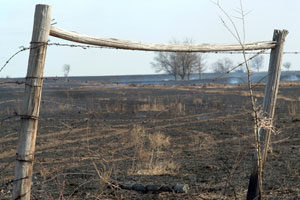Some parts of the Lone Star State have not seen any significant precipitation since August. Bayous, cattle ponds and farm fields are drying up, and residents are living under constant threat of wildfires, which have already burned across thousands of square miles.
Much of Texas is bone dry, with scarcely any moisture to be found in the top layers of soil. Grass is so dry it crunches underfoot in many places. The nation's leading cattle-producing state just endured its driest seven-month span on record, and some ranchers are culling their herds to avoid paying supplemental feed costs.
May is typically the wettest month in Texas, and farmers planting on non-irrigated acres are clinging to hope that relief arrives in the next few weeks.
"It doesn't look bright right at the moment, but I haven't given up yet," said cotton producer Rickey Bearden, who grows about two-thirds of his 9,000 acres without irrigation in West Texas. "We'll have to have some help from Mother's Nature."
That the drought is looming over the Southwest while floodwaters rise in the Midwest and South reflects a classic signature of the La Nina weather oscillation, a cooling of the central Pacific Ocean.
This year's La Nina is the sixth-strongest in records dating back to 1949.
"It's a shift of the jet stream, providing all that moisture and shifting it away from the south, so you've seen a lot of drought in Texas," Mike Halpert, deputy director of the federal government's Climate Prediction Center in Silver Spring, Md.
He said the pattern is "kind of on its last legs," and he expects a neutral condition for much of the summer.
Victor Murphy of the National Weather Service in Fort Worth said the location for the wet weather and the drought "is textbook."
"You tend to get real strong demarcation, and this year the magnitude of the extremes is exaggerated," Murphy said.
Texas' state climatologist, John Nielsen-Gammon, said the state's average rainfall from October through April was 5.82 inches. The previous seven-month record came at the end of March 1918, when the statewide average was 5.85 inches.
Houston has received only 1.5 inches in the last three months _ just 15 percent of its normal amount and less than some parts of the Sahara desert get during the same period of time.
"There's not much drought outside of the states that directly border Texas. And unfortunately, Louisiana and Mississippi are going to have to deal simultaneously with droughts and floods," Nielsen-Gammon said. "That's like the worst of both worlds."
Texas is now drier than in 1951, the first year of a six-year drought. But it's not nearly as dry as 1956.
The current dryness is close to the surface, affecting plants with shallow roots. Last summer, heavy rains drenched most of the state, but the faucet shut off in September.
Now the ground is cracking in parts of many drought-stricken states, including Oklahoma, where it's exceptionally dry in the west and wet in the east.
The town of Boise City has gone 227 days with no more than a quarter-inch of rain in a single day and then only rarely. Farmers are watching as their crops dry up and die.
"They make the best of what they have to deal with and go right on because, unfortunately, in agriculture you can't stop," said Cherrie G. Brown, a conservationist for the U.S. Department of Agriculture's Natural Resources Conservation Service. "You just have to keep going on."
In eastern Oklahoma, heavy rains caused flooding over the past few weeks.
"While it may have seen too much rainfall, it was important they saw any rainfall," said Gary McManus, the associate state climatologist for Oklahoma.
The parched landscape means the threat of fire is never far away. On Monday, the National Weather Service issued "red flag warnings" _ meaning conditions are ripe for fires in portions of Arizona, Colorado, Kansas, Nebraska, New Mexico, Oklahoma and Texas.
Texas firefighters have battled hundreds of wildfires that have charred more than 3,500 square miles since November. Humidity of less than 10 percent and wind gusts up to 45 mph across most of West Texas could lead to more blazes.
In addition to the drought, this year's fires are also being fueled by the heavy vegetation that flourished in last year's rains, then died and dried out.
In Kansas, firefighters have managed to keep a grass fire within the boundaries of the Cimarron National Grassland. The flames have been fanned by winds up to 40 mph and have consumed about 30 square miles since Sunday.
"We recommend everyone be extremely cautious," Kansas Division of Emergency Management spokeswoman Sharon Watson said Monday. "Wind conditions can make things extremely dangerous given the drought."
In addition to numerous small blazes handled by local firefighters, the state in the past couple of months has battled several large grassfires in parched western Kansas that have charred more than 118 square miles.
In New Mexico, the first three months of the year have marked the second-driest start to any year on record. On Monday, a couple of new fires started, adding to the more than 400 that have scorched more than 490 square miles.
Officials plan to close Lincoln National Forest in southeastern New Mexico on Thursday. At least two other national forests have imposed various stages of fire restrictions, and the New Mexico State Forestry Division has enacted restrictions across all but parts of four northern counties.
Colorado forest officials said Monday that crews were fighting a wildfire about 100 miles southwest of Denver on about 125 acres in the Pike National Forest near Kenosha Pass. The flames forced hikers and campers out of the area Sunday. ![]()
Associated Press writers Seth Borenstein in Washington, Roxana Hegeman in Wichita, Kan., Sheila V Kumar in Denver, Kristi Eaton in Oklahoma City and Sue Holmes in Albuquerque, N.M., contributed to this report.








